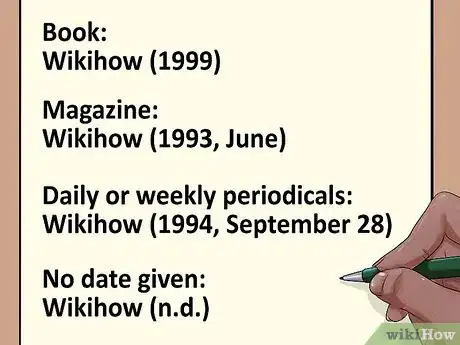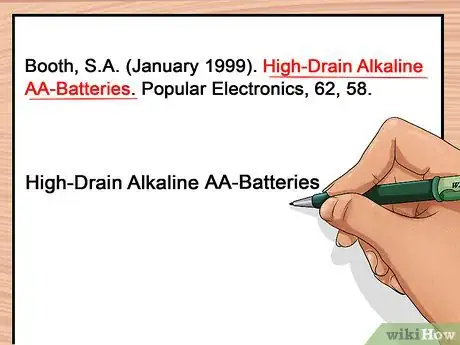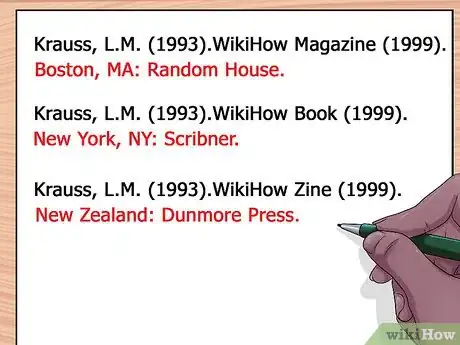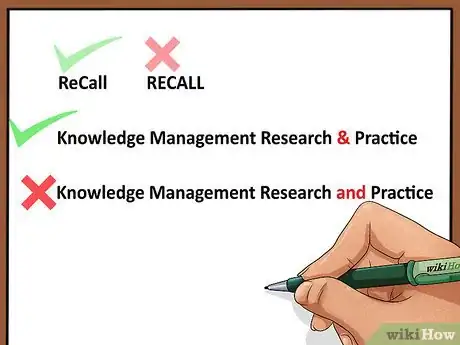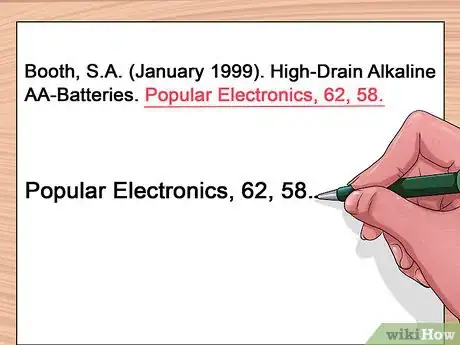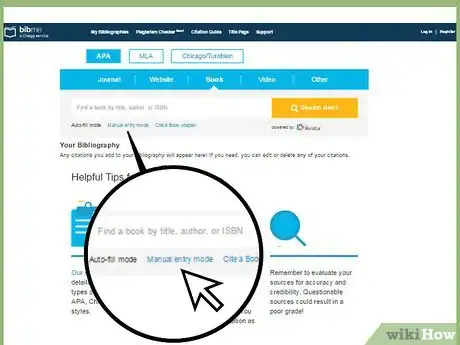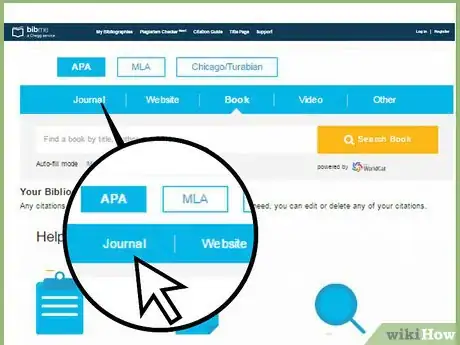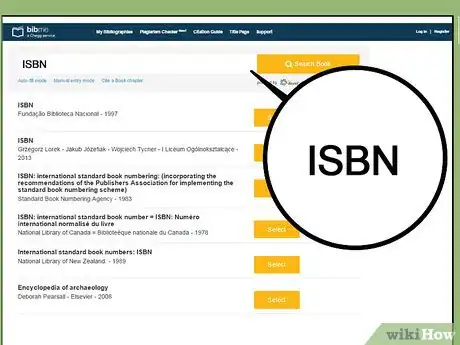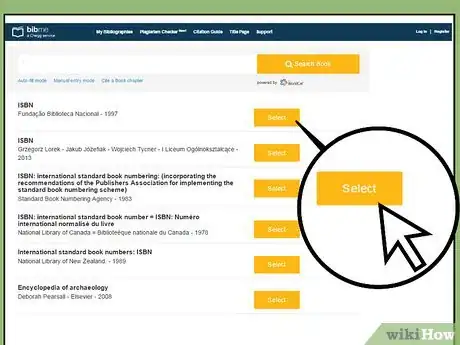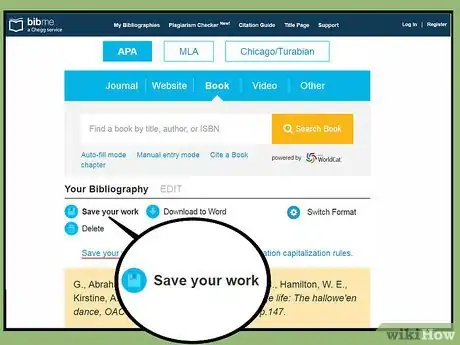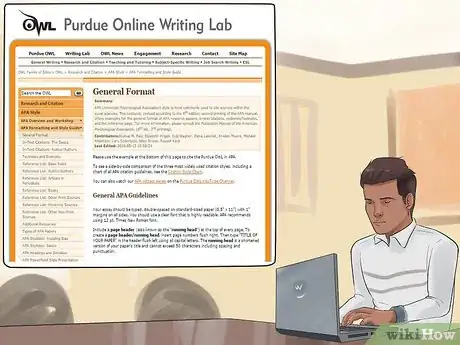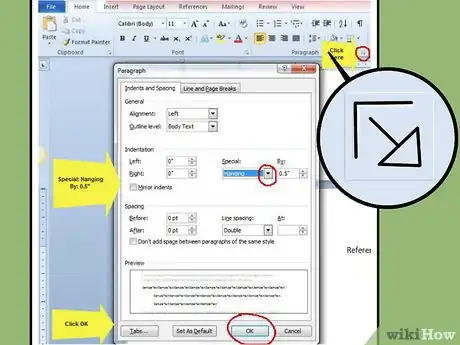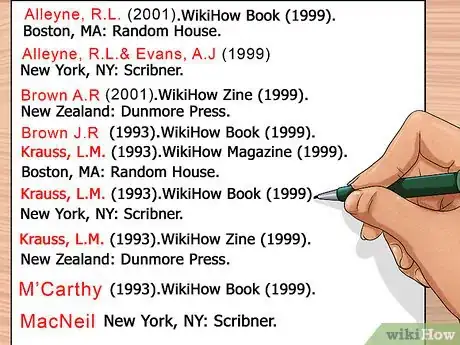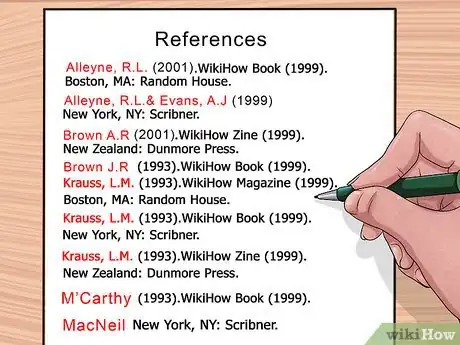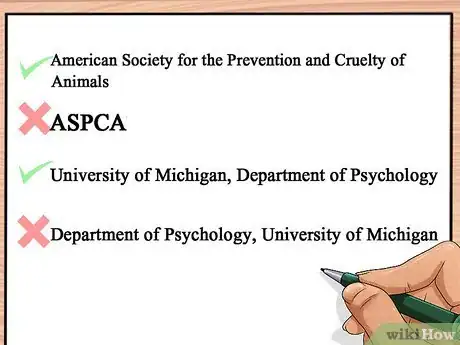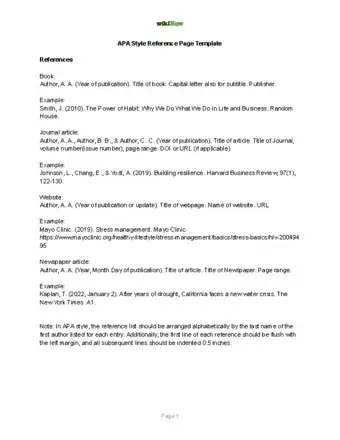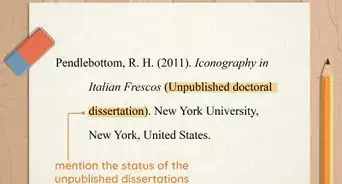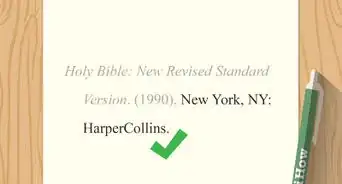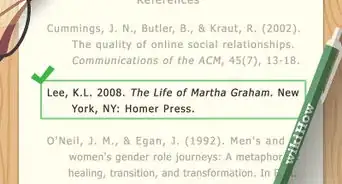This article was co-authored by Michelle Golden, PhD. Michelle Golden is an English teacher in Athens, Georgia. She received her MA in Language Arts Teacher Education in 2008 and received her PhD in English from Georgia State University in 2015.
There are 13 references cited in this article, which can be found at the bottom of the page.
wikiHow marks an article as reader-approved once it receives enough positive feedback. This article received 13 testimonials and 86% of readers who voted found it helpful, earning it our reader-approved status.
This article has been viewed 900,607 times.
Once you finish writing a research paper, you will need to cite the sources you used to do your research. How you format your Works Cited page depend on the style guidelines you are required to use. The American Psychological Association (APA) citation style is primarily used in the social sciences. This format differs from the Modern Language Association (MLA) style because it emphasizes the date by placing it earlier in the citation, and it helps reduce bias by using only the last names and first initials of the author, thereby removing gender from the author’s name.
Steps
Creating APA Style References Manually
-
1List the author’s last name. For each source, list the author’s last name and first initials. Use a comma to separate the author’s last name and initials. Then, place a period after the initials. If you need to list two authors for the same source, then use an ampersand between the two authors’ names instead of using the word and. If you need to list three to seven authors' names for one source, then place commas between the authors’ names and place an ampersand before the last author's name.[1] To list more than seven authors, add a comma between the authors' names, then use an ellipses to stand in for any authors between the sixth author and the final author. Place an ampersand before the final author's name as well.[2]
- Example of one author: Krauss, L. M. (1993).
- Example of two authors: Wegener, D. T., & Petty, R. E. (1994).
- Example of three or more authors: Kernis, M. H., Cornell, D. P., Sun, C. R., Berry, A., Harlow, T., & Bach, J. S. (1993).
- Example of more than seven authors: Miller, F. H., Choi, M. J., Angeli, L. L., Harland, A. A., Stamos, J. A., Thomas, S. T., . . . Rubin, L. H. (2009). Book title. New York, NY: Basic Books.
-
2List the publication date. After the author’s name, list the date that the material was copyrighted. For unpublished works, give the date that the material was written. Write the year out in full, in parentheses, followed by a period.[3]
- Example, book: (1999).
- Example, newspaper, magazine, newsletter: (1993, June).
- Example, daily or weekly periodicals: (1994, September 28).
- Example, for a work with no date given: (n.d.)
Advertisement -
3Enter the title of the source. After the date, the next item in each of your references should be the title of the source followed by a period. Also make sure that you only capitalize the first word in the title and the subtitle, if there is one.[4]
- Italicize book titles. For example, Call of the wild.
- Do not italicize journal, newspaper, or magazine titles. Just include these as normal text. For example, “Making the grade in chemistry: A story of trial and error.”
-
4Include the publisher's location and name. You only need to include the publisher's location and name for books. After you list a book title, list the place of publication of the book. Include the city and state for U.S. Publications, or the city, state (or province) and country name for non-U.S. Publications. Follow this with a colon, then the name of the publisher. Follow the publisher's name with a period.[5]
- Example: Boston, MA: Random House.
- Example: New York, NY: Scribner.
- Example: Palmerston North, New Zealand: Dunmore Press.
-
5Write out publication titles in full. After the title of an article, include the name of the publication. Use the full name of the journal, magazine, or newspaper, and use the same capitalization and punctuation that the publication uses. Capitalize all major words in publication titles and italicize the publication's name as well.[6]
- For example, ReCall instead of RECALL, and Knowledge Management Research & Practice, not Knowledge Management Research and Practice.
- Use the ampersand if the journal does, instead of spelling out the word and.
-
6Add the volume, issue, and page numbers for periodicals. Following the publication name, include the volume number, then the issue number in parentheses, and then the page numbers of the section you referenced in your essay. Make sure that you italicize the volume number, but not the issue number or page numbers. Follow up the last page number with a period.[7]
- Title of Periodical, volume number (issue number), pages referenced.
- For example, Psychology Today, 72 (3), 64-84 or The Statesman Journal, 59(4), 286-295.
-
7Add the URL for online publications. When citing an article or other source that you found online, it is helpful to include the url. At the end of your reference, include the words "Retrieved from" and then provide the url.[8]
- Example: Eid, M., & Langeheine, R. (1999). The measurement of consistency and occasion specificity with latent class models: A new model and its application to the measurement of affect. Psychological Methods, 4, 100-116. Retrieved from http: // www.apa.org/journals/exampleurl
- You do not need to include your date of access for APA references.
Creating APA References with an Online Generator
-
1Choose an online generator. There are many good generators online that will format your citations automatically. Most of these are free services. Free generators that provide formatted citations instantly include Bibme [9] and Citation Machine.[10] Find a generator, and click the box that says “APA.”
- Some generators require you to supply your email address and they will send you the citations. It's best to avoid these, because they may sell your information to businesses that will clog your inbox with spam.
- Many searchable library databases also provide citations in multiple styles, such as EBSCO. If you are using your university library’s databases, then you should have the option of getting an APA style citation for the source from the article’s page in the database.
- Just remember to check any references that you get from an online generator for accuracy because they may have errors.
-
2Select auto-fill or manual-entry mode. Most online generators default to the automatic entry method, but you should check to make sure you're in the right one. If you want to use the manual method instead, check that option now. Whether you use auto-fill or manual-fill is your personal preference.[11]
- The auto-fill method will supply a lot of information instantly, which you will then verify to make sure it's correct.
- The manual entry method will give you a form to complete yourself, and you will enter the appropriate author names, dates, and other relevant information manually.
- Make sure to select the type of work you are citing. The BibMe generator has five main boxes: Journal, Website, Book, Video, and Other. Click on the box that corresponds to the type of work you need to cite.[12]
-
3Enter the title or url. Depending on the type of source you need to cite, you may have a title or a url. You can enter either the title or the url into the generator's text entry box.[13]
- For a journal, enter the title of the journal.
- For a website, enter the URL or a keyword. Generally, using the url for the source will get more accurate results.
- For a book, enter the book title, author's name, or ISBN. You can find the ISBN on the book jacket, usually next to the price and the barcode. The ISBN will provide the most complete information.
- For a video, enter the URL or a major keyword. The URL will yield more specific results.
- If you choose “Other,” you will see a long list of alternative formats to choose from. Select the one that is appropriate (e.g., Magazine Article, Blog/Podcast, Painting/Artwork), and follow the prompts to enter the publication details manually.
-
4Locate the correct work from the list provided. The generator will come up with a list of possible alternatives that match the work you need to cite.
- If you supply specific information (such as a URL or ISBN), this will be a short list.
- If you enter less specific information (such as a keyword), you will get a longer list. Your source may or may not be included, depending on whether the generator located it. If your source is not on the list, then try supplying more specific information, or using the manual-fill entry mode.
- If you enter a common book title, then you will see a list of options. Check the author and date to be sure you're choosing the right one. For example, the book title Nemesis will return a list of 20 different books, each written by a different author.
-
5Click on the appropriate book title. The generator will provide a form with all the possible details you might need to supply for that type of work. The relevant information should be filled out for you, although you may need to fill in a few blank boxes yourself.[14]
- Your references should always include title, author, publication date, publication location, and publisher. If any of these are missing, then you'll need to refer to the work itself to find that information.
-
6Click on “Create Citation.” There should be a button at the bottom of the form prompting you to create the citation. When you select “Create Citation,” the generator will format the reference for you in proper APA style.[15]
- Copy and paste the generated citation if you want to add it to your references manually.
- Continue to enter more works if you want the generator to compile an alphabetized reference list of all your references.
-
7Save your citations as you go. If you choose to create multiple citations, most online generators will compile the complete list for you, and you can copy and paste it (or download it) when you are finished. However, it is a good idea to cut and paste them into a temporary list as you go, to prevent accidentally losing your work.[16]
-
8Check your work. When you have compiled your references, read through them to make sure there are no mistakes. The OWL Purdue Online Writing Lab has a comprehensive APA style guide, which you can check against your list to make sure everything looks correct.[17]
- Check for misspellings or glaring omissions, such as missing dates or author names.
- Check to be sure you have included every source you wanted to include.
Formatting and Ordering Your References
-
1Create your “References” page. Your references page should be a new page after the last page of your paper. Type the word “References” on the first line of the page, and center it.[18]
- Do not use bold, italics, or quotation marks on the word “References.”
- Double space the entire “References” page.
- Do not add an extra line between the title '”References” and your first reference item.[19]
-
2Use hanging indentations. When including references, indent all lines except the first line. The first line should be flush with your left margin. The second and subsequent lines of the citation entry should be indented ½ inch from your left margin.[20] In your word processing program, you can apply hanging indentations to the entire list of references.
- To set your indentations to hanging, open the “Paragraph” dialog box by clicking the small arrow to the right of “Paragraph” near the top of your MS Word document.
- After the box opens, look for the section called “Indentation.”
- Click on the drop down menu called “Special” that is in this section and select “Hanging.”
- Your entries will now automatically have hanging indentations.
-
3Alphabetize your sources. Create an alphabetized list of your sources using the author’s last name. If the source you are using contains two or more authors, use the last name of the author listed first in the citation.[21]
- Alphabetize letter by letter. Remember that “nothing precedes something,” or in other words, the shorter version of two similar names should come first. For example, Brown, J. R. would come before Browning, A. R.
- Alphabetize the prefixes M', Mc, and Mac exactly as they are shown. Do not alphabetize them as if they were all spelled out (Mac).
- Ignore apostrophes in names. For example, MacNeil would come before M'Carthy.
-
4Order titles by the same author chronologically. If you have two or more works by the same author (or two authors with the same name), list the works chronologically with the earliest publication first and the most recently published last.[22]
- List one-author entries before multiple-author entries, when the first author is the same. For example, “Alleyne, R. L. (2001).” would come before “Alleyne, R. L. & Evans, A. J. (1999).”
-
5Alphabetize group authors as you would single authors. Alphabetize group authors (or no authors) by the first significant word in the name. Use the full official name of the group or organization. A parent company or organization should be listed before its subsidiary group or organization.[23]
- For example, “American Society for the Prevention and Cruelty of Animals,” not “ASPCA”.
- For example, “University of Michigan, Department of Psychology,” not “Department of Psychology, University of Michigan”.
-
6Use the book title if there is no author name. When there is no single author or group author listed for a publication, the title of the work moves up to the author position in the citation. Alphabetize these listings by the first significant word in the title.[24]
- For example, “Merriam-Webster's collegiate dictionary (11th ed.). (2005) Springfield, MA: Merriam-Webster."
APA Style Reference Page Template
Community Q&A
-
QuestionWhat do you do if the authors name is not indicated?
 Community AnswerSometimes it is difficult to locate an author for an online source. If you absolutely can't find an author's name, you can use the name of the organization that published the article (for example, "California Department of Health," or "American Humane Society"). If you can't find a specific name for the organization, you can use the title of the article, website, or blog.
Community AnswerSometimes it is difficult to locate an author for an online source. If you absolutely can't find an author's name, you can use the name of the organization that published the article (for example, "California Department of Health," or "American Humane Society"). If you can't find a specific name for the organization, you can use the title of the article, website, or blog. -
QuestionDo I need to write a summary of the article?
 Community AnswerAn annotated bibliography contains additional information for each source; a standard bibliography does not. If your teacher asks for additional information, you should include it.
Community AnswerAn annotated bibliography contains additional information for each source; a standard bibliography does not. If your teacher asks for additional information, you should include it. -
QuestionCan I use a URL in my bibliography?
 Community AnswerYes, if you want. Many teachers recommend it so they can check your information. Also, most standard style guides require the inclusion of a URL for an online resource.
Community AnswerYes, if you want. Many teachers recommend it so they can check your information. Also, most standard style guides require the inclusion of a URL for an online resource.
References
- ↑ https://owl.purdue.edu/owl/research_and_citation/apa6_style/apa_formatting_and_style_guide/reference_list_author_authors.html
- ↑ https://owl.purdue.edu/owl/research_and_citation/apa_style/apa_formatting_and_style_guide/reference_list_basic_rules.html
- ↑ https://owl.purdue.edu/owl/research_and_citation/apa_style/apa_formatting_and_style_guide/reference_list_electronic_sources.html
- ↑ https://owl.purdue.edu/owl/research_and_citation/apa_style/apa_formatting_and_style_guide/reference_list_electronic_sources.html
- ↑ http://www.waikato.ac.nz/library/study/referencing/styles/apa
- ↑ https://owl.purdue.edu/owl/research_and_citation/apa_style/apa_formatting_and_style_guide/reference_list_basic_rules.html
- ↑ https://owl.purdue.edu/owl/research_and_citation/apa_style/apa_formatting_and_style_guide/reference_list_articles_in_periodicals.html
- ↑ https://apastyle.apa.org/style-grammar-guidelines/references/dois-urls
- ↑ http://www.bibme.org/
- ↑ http://www.citationmachine.net/
- ↑ http://www.bibme.org/
- ↑ http://www.bibme.org/
- ↑ http://www.bibme.org/
- ↑ http://www.bibme.org/
- ↑ http://www.bibme.org/
- ↑ http://www.bibme.org/
- ↑ https://owl.purdue.edu/owl/research_and_citation/apa_style/apa_formatting_and_style_guide/general_format.html
- ↑ https://writingcenter.uagc.edu/format-your-reference-list
- ↑ https://libguides.jcu.edu.au/apa/reference-list
- ↑ https://writingcenter.uagc.edu/format-your-reference-list
- ↑ https://libguides.jcu.edu.au/apa/reference-list
- ↑ https://owl.purdue.edu/owl/research_and_citation/apa_style/apa_formatting_and_style_guide/reference_list_basic_rules.html
- ↑ https://owl.purdue.edu/owl/research_and_citation/apa_style/apa_formatting_and_style_guide/reference_list_author_authors.html
- ↑ https://apastyle.apa.org/style-grammar-guidelines/references/missing-information
About This Article
To write an APA style "References" page, list your sources in alphabetical order on a new page at the end of your document. Seperate each source with a hanging indent, which will make the first line of each source flush with your left margin and every other line indented. For each source, include all required bibliographic information, like the author's name and the date of publication. You can use an APA citation generator, like Bibme or Citation Machine to help you format each citation correctly. To learn how to do manual citations in APA style, keep reading.

